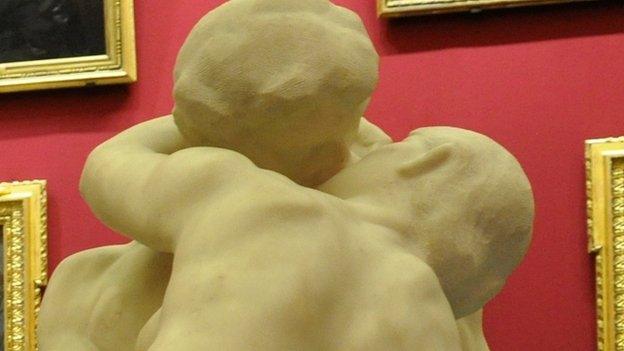First kiss: Rodin's sculpture makes debut in Scotland
- Published

One of the world's most famous sculptures is on display in Edinburgh for the first time. The eroticism of Rodin's The Kiss caused controversy when it was first displayed but over the past century it has become the best-known sensual sculpture in Western art.
The director of the National Galleries of Scotland, Michael Clarke, says Auguste Rodin's sculpture is "rightly acknowledged as one of the greatest artistic evocations of desire ever created".
He calls it a "great hymn to love".
The Kiss depicts the passionate adulterous embrace of Paolo Malatesta and his brother's wife Francesca da Rimini, characters in Dante's 'The Divine Comedy'.
Dante tells how the couple's passion grew as they read together the story of Lancelot and Guinevere and the book can be seen dropping from Paolo's hand in the sculpture.
The French sculptor had originally used the image as a detail in an early version of The Gates of Hell, a monumental work that preoccupied him for the last 37 years of his life.

The Kiss will be on display at the National Galleries of Scotland for a year
It was a theme Rodin developed in plaster and terracotta before the French government gave him a huge block of marble to create a showpiece for the great exhibition of 1889.
Rodin missed the deadline and it languished, forgotten, for nine years.
When the artist did show The Kiss, he got two new commissions - one from England and one from Copenhagen.
The one that will be on display in Edinburgh for the next year was bought for an American collector living in Sussex.
Edward Perry Warren paid Rodin 20,000 French Francs for the sculpture, a large sum at the time, but when The Kiss finally arrived, in 1904, it was put into the stables at Lewes House.
It is not known if this was because it was too big for the house or did not live up to Warren's expectations.
In 1914, Warren lent it to Lewes town council for display in the town hall but its amorous subject matter scandalised local residents.

The Kiss is on loan from the Tate in London
Shortly afterwards soldiers were billeted in the town hall at the start of the war and it was hastily draped in a tarpaulin so that it would not "over-excite" the troops.
After Warren's death in 1928, The Kiss was put up for auction but failed to attract its asking price.
In 1952, the Tate launched a public appeal to buy the sculpture for the nation for the bargain price of £7,500.
It is The Kiss from the Tate that has been loaned to Edinburgh.
Art historian Anne Ellis says the Tate sculpture is much rougher than the original Paris version.
She says Rodin "did not let his hands go anywhere near the marble".
"It is a heavy job for a man coming up for 50, carving these big marble statues," she says.
"They always used assistants and this assistant finished before the statue was finished, as it were.
"So the faces have not been perfectly carved out of the rock. The faces have not been separated so they are still almost kissing, as it were, in opposition to the story."
Ms Ellis says, in Dante, Paolo and Francesca are spotted by her husband Giovanni before the kiss lands.
The outraged husband stabs and murders the pair.
Ms Ellis says it is not her favourite Rodin sculpture.
"The problem is, and Rodin acknowledged this, he had taken this huge statue from a very small model.
"The monumental size of it, the scale of it, for me, diminishes any chance of him showing any subtlety in the idea of a kiss."
Radio presenter Vic Galloway was among the first to see the sculpture in its new temporary home and was "in awe" at it.
He told BBC Scotland's Culture Cafe that he disagrees with Ms Ellis.
He says: "I think the roughness of the sculpture and the fact that two figures emerge from the stone itself adds to the eroticism of it and to the raw emotion of it.
"They are obviously committing a crime of passion, the two of them are locked in this embrace and they shouldn't be.
"The fact that it is huge and imposing seems to reflect that emotion - it is sexual, it's erotic.
"It does not have to be subtle and delicate, I think."